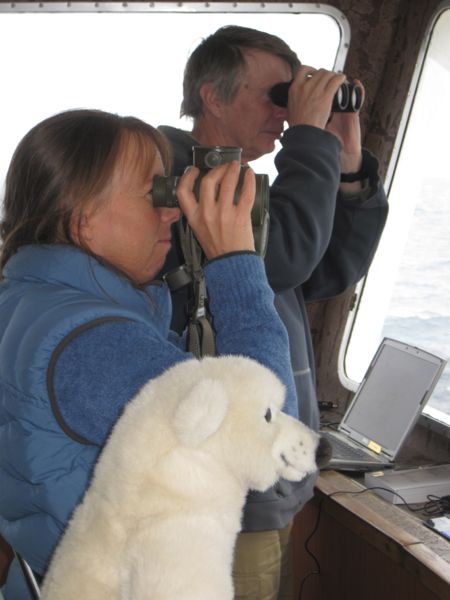With the exception of short stops for geology and benthic grabs for the Russian teams, we've been transiting for two days. While some on board have had a break there are two scientists who are rarely seen when the ship is moving during daylight hours. That's because they spend the majority of that time on the bridge watching for birds (Declan Troy) and marine mammals (Kate Stafford).
Declan is originally from Toronto, but he now lives in Anchorage where he does his own research and goes out on research cruises when he finds one heading for an interesting area. He had heard of the RUSALCA program and wanted to join the cruise but was told it was full. When someone had to drop out, Declan jumped at the opportunity because he was particularly interested in observing birds along the Russian coast. His work on board is officially for the Fish and Wildlife Service, Migratory Bird Management. His interest in seeing the birds along the Russian coast is related to several birds that he's tracked in Alaska that move to the Russian coast in the fall. He wonders what makes this area so desirable for those birds, and he hopes that his observations and the work of the other scientists on board will help him to understand this areas' attraction – from a bird's point of view. Although we haven't spent as much time along the coast as Declan would have wanted, he has seen unexpected birds on the ice. For instance, he expected to see the Short-tailed Shearwater, but not as far into the ice, and the Kittyhawks he's seen on the ice were expected but not in the abundance he's observed. While on the bridge, Declan watches a 300 meter wide survey zone and records all birds on the water. For the flying birds, he relies on a bell on his computer that rings every 300 meters. At that point, he gets a count of the flying birds. His computer has several settings that allow him to record his sightings easily and keep track of the ship's position.
Kate Stafford, senior oceanographer from the Applied Physics Laboratory, University of Washington where is our marine mammal observer on board. Although she's had days, particularly those when we're not close to land, when she's seen very few mammals, she has seen walrus, polar bears, bowhead, gray and humpback whales, as well as ringed, bearded, spotted, and ribbon seals. When I visit the bridge and Kate spots something, it's always tough for me to find it even with the binoculars. She's got a great eye for picking out mammals and birds on the water, even at a distance. She can tell the difference between bowhead, gray, humpback, and right whales when recording what she sees. To identify a whale to species, Kate needs to see some part of the body in order to look for what she calls specific diagnostic bits. Right whales are identified by callosities on their heads, clusters of a particular species of barnacle unique to right whales, bowheads by their `stack´ the conical shape of the top of their massive heads, grays by the knuckles (ridge of dorsal bumps) near the tail, and humpbacks by their dorsal hump and distinct small dorsal fin.
Kate told me that she averages 4-6 months each year in fieldwork, and she's worked in every ocean in the world. Her primary job has been to put hydrophones in full oceanographic moorings where they'll collect data for a full year. Her goal is to integrate those sounds (from marine mammals) with environmental variables such as temperature, depth, chlorophyll, and sea ice. She was very interested in this cruise because there is so little known about the mammals on the Russian side of the Chukchi Sea. When she was on the RUSALCA mooring cruise in 2010 she observed that the diversity and abundance of marine mammals is much higher on the Russian side. She feels the differences may be related to the fact that these (Russian and US sides of the Chukchi) are two very different oceanographic systems, in part due to the different currents in each area.
During the 2009 cruise, our marine mammal observer talked to me about the importance of the bowhead whales to the native communities. Eleven native Alaskan communities take bowhead whales and share a five-year quota set by the International Whaling Commission. Management is primarily local and is done through the Alaska Eskimo Whaling Commission in conjunction with NOAA. Barrow, Alaska, is one of the communities that takes bowheads. Their hunt had traditionally been in the spring, conducted from the sea ice, but now the largest hunt is often conducted in the fall from boats, due to the changing pattern and potential instability of spring ice.



Comments